Part 3: Biomolecules to living organisims
1/31
There's no tags or description
Looks like no tags are added yet.
Name | Mastery | Learn | Test | Matching | Spaced |
|---|
No study sessions yet.
32 Terms
Double coding theory
Explains that life began on clay particles.
According to this point of view, coding arose first, but the coding material was the surface of naturally occurring clay.
The coding system and the coding role of your RNA, and the catalysis role of your RNA came about separately, and rhe combination of the two produced life.
A theory also suggest that nauna muna ang coding characteristic ng RNA bago nag develop ang kanyang catalitic activity.
RNA was first produced because it can both perfom its “coding characteristic” and its “catalitic activity.”
Protocells
Double-origin theory
Nucleotides, then RNA molecules, formed on the clay surface. The RNA molecules thus formed were released from the clay surface and enclosed in lipid sacs, forming?
In some other theories these are also called “coacervates”
Lipids
They are good in protecting the cells, because of their insulating properties, they are able to insulate cells, to insulate the RNA and protect the, from the external environment.
How cells have originated
In this picture we can make a question on how the cells are formed from those interactions, what will happen if the cell goes into a hot pond, what will happen to the RNA molecules?
RNA tends to separate into two different identical strands, but why does it need to do that? It is because once your cell reaches the cold environment, it divides into two identical cells, containing the same type of RNA. This is actually an early description of cellular division, how cells multiply, how cells reproduce.
A cell must undergo first a central dogma, you have DNA replication, copying its own cell, transcription to mRNA and then your mRNA will produce protiens to support the cellular division, that will occur later on.
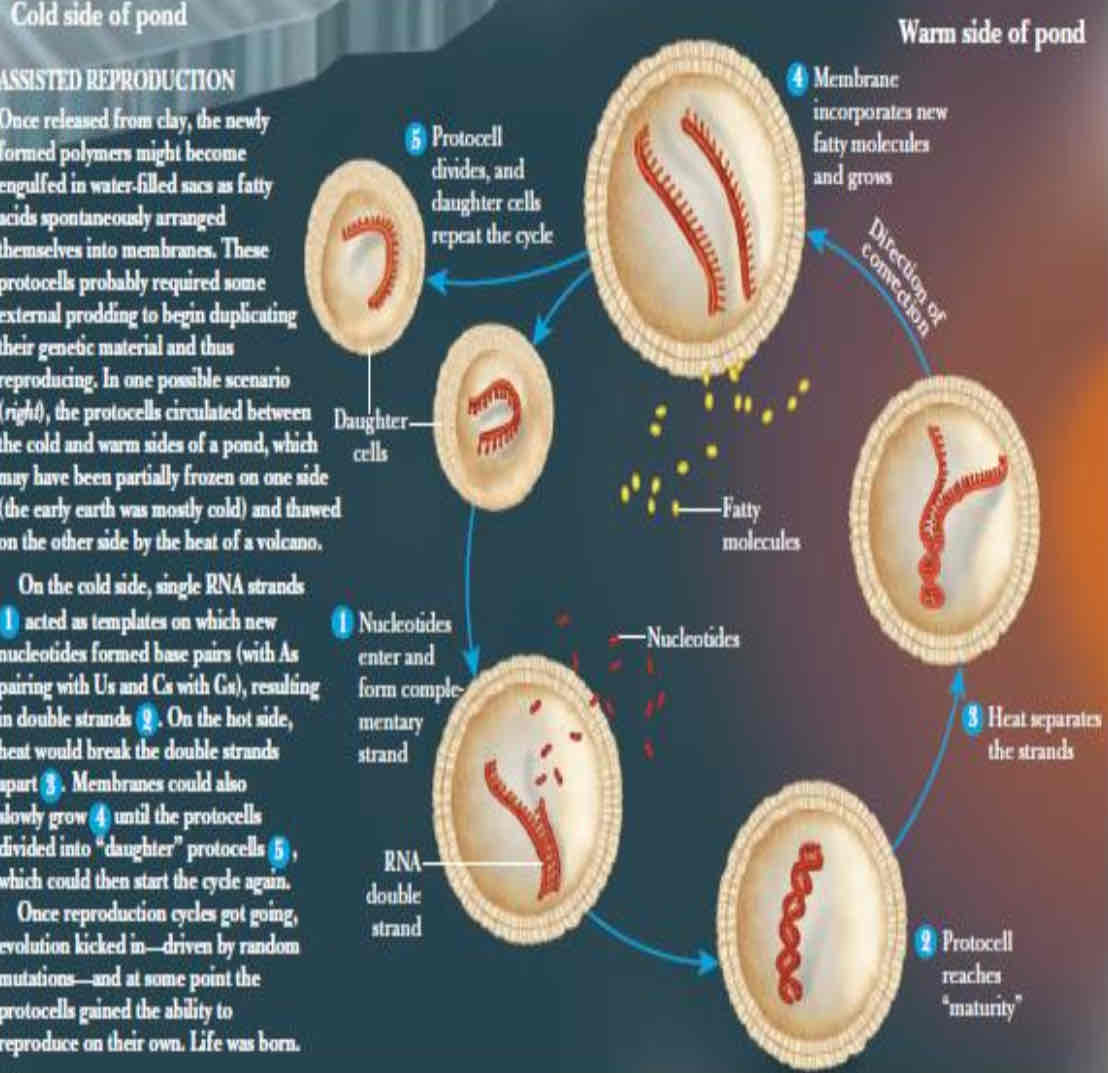
Woesse and fox
The domain system was developed and published in 1970 by
Before the groupings of all living organisims is based only on their physical characteristics.
Before Carl Linineus, was able to group all organism into two groups, those are the plants and animals.
Now in 1970.
The genotipic studies was new back then, now these scientist introduced a new grouping that superceeds your 5 kingdom system, that is your “domain system”, ang basis nito is its physical characteristic on the basis of its cellular structure, prokaryotic cell, and eukarotic cell, and then genotipic characteristic through its genotipic relatedness.
3 domain system
kung nakikita niyo dito, we have 3 big domains, the domain of Archea which is called as “ancient” because the organisms that belongs here is the same with the first organism, which is referred to as LUCA ( Last universal common ancestor), which is similar to the LUCA, thats why it is called as ancient because characteristically and phenotipically, it looks like the prokaryotic cell ( the first cell to be discovered, or the first cell to appear billions of years ago are prokayotic in nature, thats why archea is called as ancient).
Then we have the domain Eubacteria, also known as the “true prokaryotic cells”or the true bacteria.
And on the otherhand we have, domain Eukarya, which means that most of the organisims here has a eukaryotic cell.
In some of the domain system tree, makikita niyo minsan magkabaliktad ang Archea is the main branch and Eukarya was a offshoot of an Archea, but as to this diagram your Archea is an offshoot to the domain Eukarya.
How will i be able to describe the characteristic of your Eukarya based on this diagram, your Archea is similiar in terms of its phenotipic characteristic, phenotipically similar to Bacteria, but if our basis is Genotipic relatedness, through the ribosomal RNA analysis, your Archea is related to Eukarya, you can see here they have one origin, they are genotipically related but your Archea is phenotipically similar to bacteria, which is a prokaryotic cell.
Other things that you’ll notice is Mitochondria, is grouped under bacteria, but mitochondria is seen where nowadays? It is part of the Eukaryotic cells, look at the arrow, this is the origin of Mitochondria going to Eukaryotic cells. Billions of years ago, Mitocheondia is actually a living organism, its actually a cell that eventually trough evolution under the process that we call Enocymbiosis. Mitochondria from being a cell ano ang nangyari sakanya? Na transport siya as a part of a Eukaryotic cell or what we call it now as a Organelle.
Later you will see the structure of Mitochondria ay may sariling DNA, the reason for that is because, billions of years ago it was actually a bacterial cell, that was absorbed by Eukaryotic cells sa prokayotic cell that was introduced to a Eukaryotic cell. We also have Chloroplasts, it is seen specifically on plant cells, that the same as your Mitochondria, they have undergone process of Endocymbiosis, thats why Chloroplasts have DNA thats because billions of years ago, they were cells, and through evolution they were transformed from cells into organelles.

5 Kingdom system
Proposed by Robert Whittaker in 1969
So you have the groups arranged from the lower portion of the kingdom system, papunta sa taas, yung nasa bottom are the Prokaryotic cells or organisims, bacteria, algae. Higher than them are the Unicellular Eukaryotes like protista and protozoans.
Difference of a Unicellular organism, and Multicellular organism, Unicellular is one cell is equivalent to one unit of life, Multicellular, multiple cells is equals to one unit of life, or multiple cells are needed to support life.
Upper level, kingdom of fungi, plants, and animals.
We have 2 parameters, Evolutionary age and complexity.
Based on this diagram we can therfore conclude that evolutionary age is billions of years ago upto the year 0 (is present), as the evolutionary age decreases the complexity of organisms increases. Tingnan niyo, sino ang unang nag appear billions of years ago? Bacteria, the prokaryotic cells, then their placed at the bottom of the 5 kingdom system as the evolutionary age decreases the complexity also increases, they become more complex through their cellular component.

Life in biochemistry viewpoint
Hundreds of biochemical reactions and processes occurring in sub-cellular organelles of a cell in an organized manner.
So life will not exsist without this biochemicall processess that occurs in the organelle.
Understanding how life originated means we must have a complete knowledge, at the molecular level of all biochemical reactions and processes occurring in living cells.
We can only understand life or measure the exsistence of life based on how many based on what type, or in general we can say that, if this biochemical reactions does not exsist or does not perfom at the sub cellular level, then we cannot say that life also exsists.
Features of a living matter
A high degree of chemical complexity and microscopic organization.
Systems for extracting, transforming, and using energy from the environment.
An example is by Eating, remember that life is governed by the first law of thermodynamics or the metabolic pathways that occurs in the body is governed by the first law of thermodynamics which says “energy cannot be created nor destroyed”, we do not create energy, we transform energy, or convert.
Defined function for each of an organism’s components and regulated interactions among them.
A capacity for precise self-replication, self-assembly, and reproduction with near perfect fidelity.
Our cells are able to produce exact same copies of themselves through cellular division. Cells requires biomolecules that they produce and they assemble this as a part of their component.
Mechanisms for sensing and responding to alterations in their surroundings.
A capacity to change over time by gradual evolution.
Cells
Basic structural and functional unit of life
Below cells, are not considered as a living matter, an organelle, even if its a part of the cell it is not considered as a living matter. Even Mitochondria that was composed that billions of years ago was a living cell, ngayon ang mga modern Mitochondria could not be identified as a living matter, because they are just part of the cell.
bounded by a plasma membrane; have a cytoplasm containing and have a set of genes contained within a nucleoid (prokaryotes) or nucleus (eukaryotes)
Something that stores the genetic information in Prokaryotic cell we refrer to this as NUCLEOID and in Eukaryotic cells NUCLEUS.
Modern cell theory
All organisms are composed of one or more cells and the life processes of metabolism and heredity occurs within the cell.
Cells are the smallest living things, the basic units of organization of all organisms.
Cells arise only by division of previously existing cells.
Actually this is already questionable, because we can already synthesize cells from producing young cells from matching cells, we can now synthesize cells from precursor molecules in the laboratory, but it is not yet ethically accepted.
Prokaryotes, Eukaryotes
Based on cellular organization, living organisms can be classified into 2 groups
Prokaryotes
Cells that lacks a true membrane enclosed nucleus

Eukaryotes
Cells that have a membrane-delimited nucleus and differ in many ways with prokaryotic cells
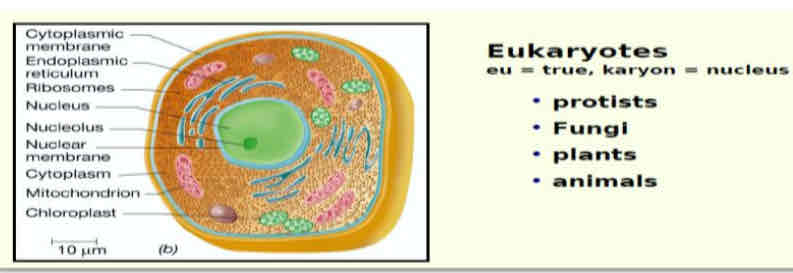
Done
These are the primary components or a comparison between the two cellular domains which is present or which is absent between the two.
We have nucleus which is absent in the Prokaryotic Cell, but hindi naman siya totally absent, iba lang ang pangalan niya, clumps of genetic component that we call "Nucleoid". The key difference between the two is the presence of a membrane.
Question. Is the membrane in your nucleoid comparable to the membrane seen in the cell? Diba ang tawag natin sa membrane ng nucleus is nuclear membrane or nuclear envelope. The answer is, its not because it is not a "Semi-permeable" membrane its actually an incomplete membrane, some biologists will not reffer to it as a membrane but just an envelope, because its less complex on what you have in the cell membrane.
Mitochondria is present in Eukaryotes and absent in Prokaryotes, kasi billions of years ago it was a bacteria that have been in incorporated na Eukaryotic cell through the process of "Endocymbiosis"
Ribosomes, is present in both cellular domains, so therfore it also acts the same mechanisim on both cells which is to produce, or involve in "Protien Synthesis".
Chloroplasts, which is not present in Prokaryotic cells, but some of it for example Cyanobacteria, blue and green algae, they are able to perform photosynthetic reaction, they still have this chloroplast like component na ang tawag is, "Chromatoforce" or "Chlorosomes".
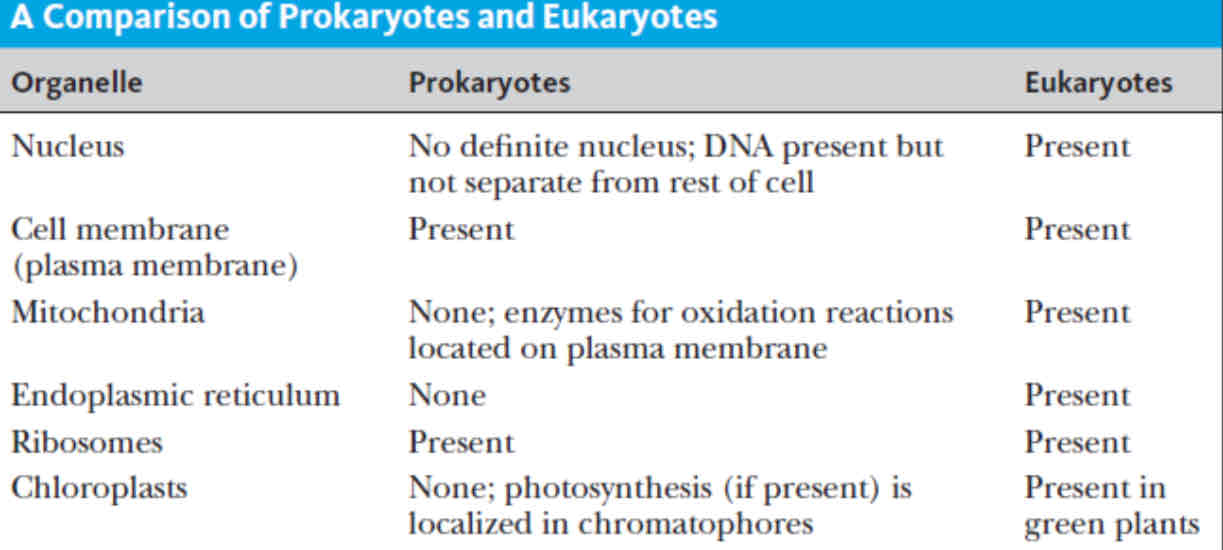
Done
Examples of Prokaryotic and Eukaryotic cells
Mycoplasmas are reffered to as "acellular" because it is actually a bacteria that do not have a Cell Wall.
In Eukaryotes we have the Fungi, on the left is a Unicellular type of fungi that is your yeast cells, and to the right is a Multicellular type of fungi we reffer to it collectively as "Molds" both molds and yeasts are fungi.
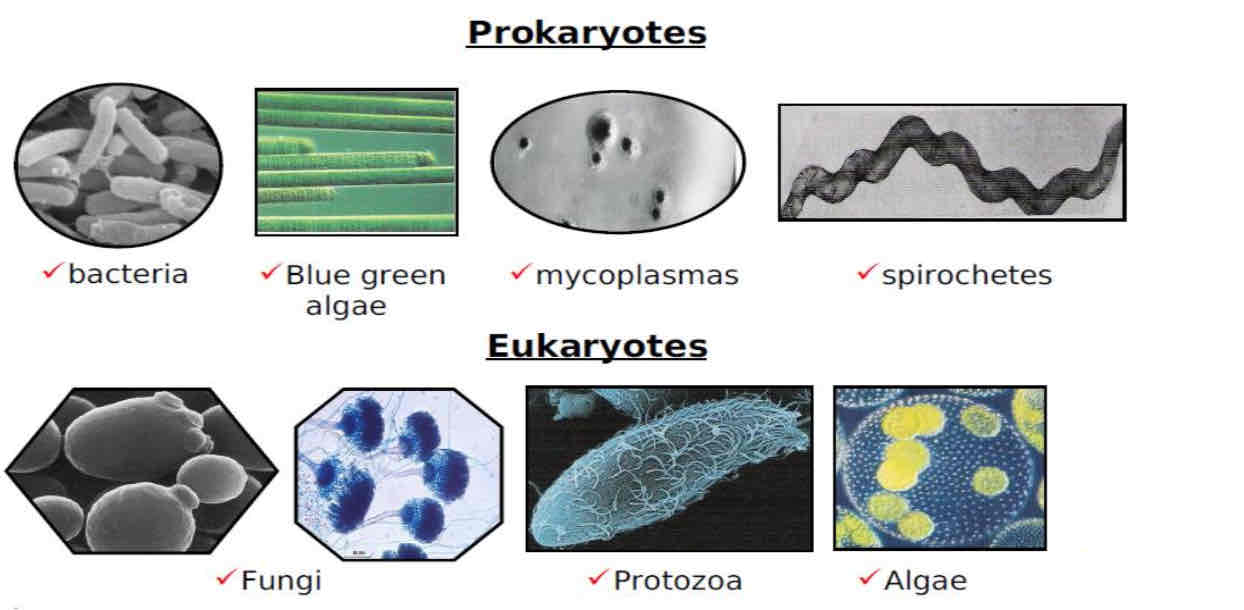
Prokaryotic Cell
Bacteria (Prokaryotes) were the earliest life form on earth (about 1 billion years)
The most widely studied prokaryotic cell is that of a bacterial cell
Cell wall: Gram (-) and Gram (+) bacteria
Genetic materials: Bacterial genome and Plasmids
Prokaryotic cells are the earliest cell kapareho niya ung Last Common Universal Ancestors (LUCA) in terms if its structural comparison, pero yung behaviour niya hindi kapareho its because of the of the harsh environment of the early days of the Earth, no oxygen, only nitrogen gases etc. compared with the bacteria that we know now thrived to the same enviroment that we are thriving aswell, some of the, are fully dependent in the presence of oxygen.
They are considered as most widely studied because they are small, they can easily reproduce, in jst 24 hours, one cell can multiply into 1k cells or more, and genetic materials can easily be extracted. By that the most widely studied bacterial cell is the "E. Coli". Size or a Prokaryotic Cell is "0.5 to 1 micro meters".
Now, aside form having a cell membrane, meron pa siyang extra cell membrane layer called as a "Cell Wall", cell wall is present in all Prokaryotic Cell, even your Archea has a cell wall, in your Eukaryotic cells only Plants and Fungi have a Cell wall.
Whats the significance of cell wall in identifying your bacterial cell, we use this in classifying your bacteria into two main groups, a "Gram Positive" and a "Gram Negative", based on their ability to respond to a staining procedure invented in 1884. Which is called a "Gram staining technique"
Diagram
This is a comparison between the structure of a gram positive bacteria and a gram negative bacteria, now to simplify that there are different things to consider for you to differentiate these two membranes or cell wall, but we look at the important biochemical component your "Peptidoglycan" or that is also reffered to as the "Urine Layer"
You look at the peptidoglycan in gram positive bacteria the color blue, vs the petidoglycan on the negative one, what do you observe? Thick yung sa gram positive than the gram negative. One of the tool to differentiate a gram positive to a gram negative bateria based on your cell wall is that gram positive has a thick Peptidoglycan Layer, whereas a gram negative bacteria has a thin Peptidoglycan Layer.
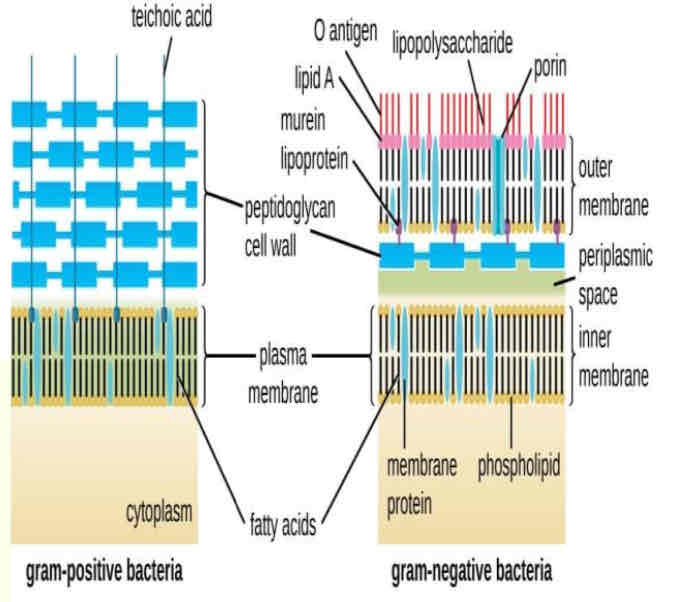
Prokaryotic cells components external to the cell wall
Now aside from the cell wall, meron ka ding mga extracellular structures that are made up of Biomolocules.
Glycocalyx
Pili
Bacterial Flagella
Glycocalyx
General term for the thick cover or layer of polymers deposited outside the cell.
If we translate that into common terminologies its just a "carbohydrate coding", its a thick layer that surrounds your cell wall, this is your cell wall, the black is the border, this part here the colorless membrane that surrounds the cell wall, thats your glycocalyx membrane.
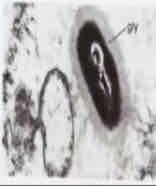
Capsule
Well organized glycocalyx
Attached firmly to the cell wall
Compact
Excludes particles like india ink
Slime Layer
Zone or diffused unorganized material
Loose association
Does not exclude particles
Pili
Hair-like structures on the surface of prokaryotic cell
Composed of protein sub-units called "pilins"
Sometimes reffered to as "fimbrae"
Two purpose of Pili
Adhesion or Attachment, we call it as P-pili
Conjugation, is referred to as "Bacterial sex", they directly transfer their genetic component through plasmic component, from one bacteria to another, this is a process of "Horizontal gene transfer" in one bacteria to another bacteria. F- Pili
Bacterial Flagella
Thread like locomotor appendages extending outward from the plasma membrane and cell wall.
Flagella is found at the sperm cell, it is for locomotion, movement, it is made up of protien called "flageli" depending on the type of flagella may ibat ibang klase ng locomotion, may gliding mobility and etc. Basta it is important in prokaryotic cell to move from point A to point B.
Eukaryotic Cell
There are 2 types of Eukaryotic cell a typical Animal Cell and Plant Cell, tinawag siya na typical its because hindi lagi ganun ang structure, it varies... but most of the plant and animal cell will assume this component.
Absent in Animal cell but is present in Plant cell
Cell wall, again sino lang ang Eukaryotic cell na may cell wall? Plants and Fungi
Chloroplasts
Vacuole, is used for storage, for plants this this is usually where your "starch" is stored, and it is used for storage of water, now in plants we usually call it as a vacuole, but in Animal cells we reffer to this as "Vesicles" because that is prepared by the Golgi Apparatus, but sometimes in general nirerefer sila as "Inclusion Bodies" (Used for storage).
Inclusion bodies actually lower down your organelles, kasi sabi kanina, all organelles are membrane delimited, and inclusion bodies in not membrane delimited, pero meron siyang coding.
Lysosome, is absent in your Plant cell, this is where the breakdown of molecules happen by hydrolytic enzymes, digestive enzymes that breaks down a molecule.
The term Phagocytosis or " Cell eating", only Animal cells have the ability to perform this, for them to digest this large component that theyhave engulfed they need this hydrolytic enzymes.
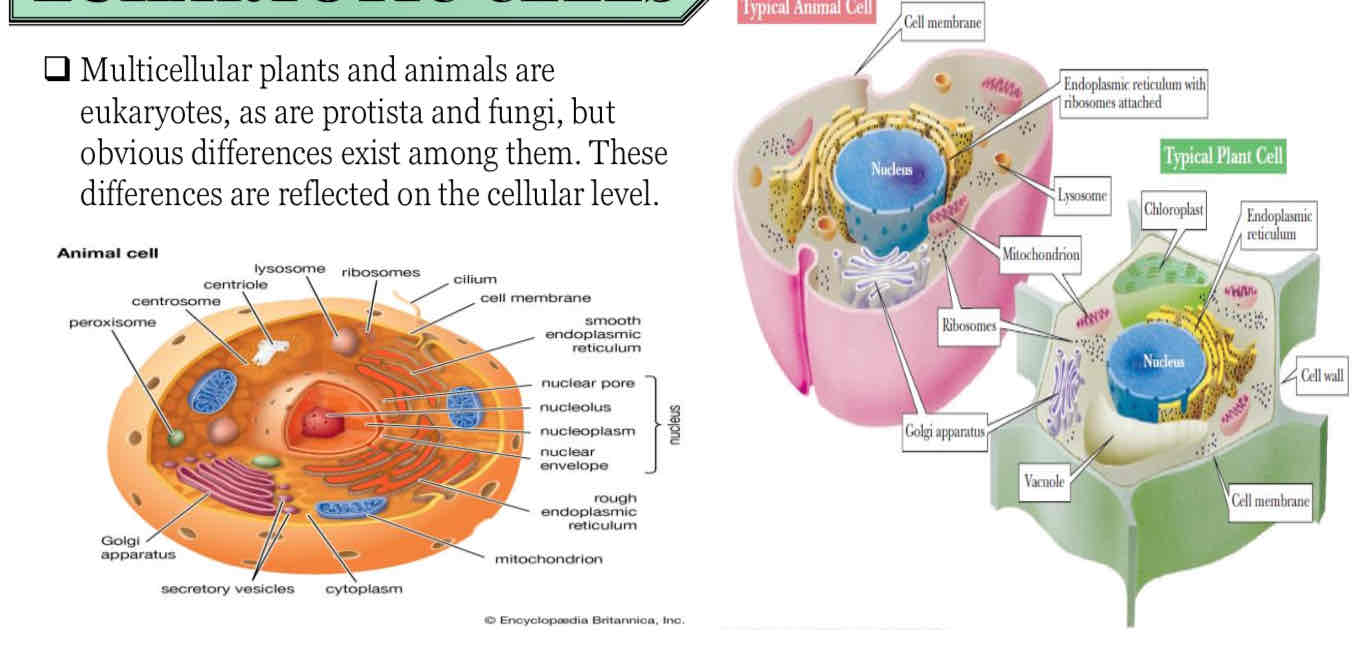
Physically
Characteristics common to all life forms
a. All living systems are composed of a basic microscopic unit called the cell.
b. The cell is circumscribed by a thin semi-permeable membrane which encloses the
protoplasm.
c. The protoplasm consists of micro- and macromolecules necessarv for life and
function.
The thin semi-permeabke membrane that surrounds the cell is the plasma membrane, or cell membrane or cytoplasmic membrane. Cell is "circumscribed" meaning its coated, its covered. Protoplasm is the older terminology for Cytoplasm.
DNA, RNA, protiens
3 common groups of macromolecules? (Chemically)
DNA
Carries genetic information which determines phenotypes.
mRNA
Carries the genetic blueprint copied from the sequence of bases in a cell's DNA.
tRNA
Carries amino acids to the ribosomes for incorporation into a protein.
rRNA
Found in the ribosomes, specialized structures that are the sites of protein synthesis.
Physiologically
All biological forms are capable of performing certain biochemical activities.
Which follows the first law of thermodynamics, energy cannot be created or destroyed. So ano ang ginagawa natin para maka create ng energy? We transform, convert energy from external sources. Physiologically we can say that all living organisms is able to perform the fist law of thermodynamics
Reproduction - ability of cells to reproduce, multiply
Food ingestion
Waste excretion
Irritability/ reaction to environmental stimuli
Susceptibility to mutation- all biomolecules are bio informational, the patten that we observe conveys information, if there is a change in that pattern, we disrupt the normal process, it makes the cell abnormal thus calling it a mutated cell, we are suseptible to mutation because of these sequences of this pattern.
Major nutritional types of microorganisms
These are how we classify microorganisims based on 3 parameters, nutritional means kung paano sila mag obtain ng nutrients sa external sources and covert it into energy. We look at the 3 important parameters:
Energy sources
Hydrogen/ electron (source of electron)
Carbon source ( source of carbon )
Just to simplyfy, we will focus on the Energy source and Carbon source
First group, Photoautotrophs
Photo-source of energy, light
Auto- source of carbon, carbon dioxide
Second group, Photoheterotrophs
Photo- source of energy, light
Hetero- source of carbon, organic substances
Third group, chemolithoautotrphs
Chemolitho- source of energy, inorganic substances
Auto- source of carbon, corbon dioxide
Last group, chemoheterotrphs
Chemo- source of energy, organic substances
Hetero- source of carbon, organic substnances